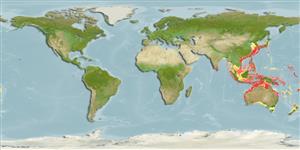Common names from other countries
Environment: milieu / climate zone / depth range / distribution range
Sinh thái học
Biển gần đáy; Mức độ sâu 20 - 200 m (Ref. 54393), usually 74 - 78 m (Ref. 54393). Tropical
Indo-West Pacific: disjunct distribution: Japan to coast of Aomori Prefecture, Honshu, the Izu Peninsula, Kochi Pref., Ogasawara Islands and southeastern Taiwan; in the south from the Arafura Sea, the NW shelf and Kimberly region of Western Australia; from Geographe Bay northwards.
Bộ gần gũi / Khối lượng (Trọng lượng) / Age
Maturity: Lm ? range ? - ? cm
Max length : 55.0 cm TL con đực/không giới tính; (Ref. 48636)
Các tia vây lưng cứng (tổng cộng): 8; Các vây lưng mềm (tổng cộng): 9; Tia cứng vây hậu môn 1; Tia mềm vây hậu môn: 7. This species is distinguished by the following characters: pectoral rays 15-16 (rarely 15); gill rakers 6-7 + 19-22 = 26-28; greatest body depth at or slightly anterior to origin of dorsal fin, 2.9-3.25 in SL; head length (HL) 2.8-3.1 in SL; snout length 1.65-1.9 in HL; cheek depth (lower edge of eye vertically to ventral margin of preopercle) 6.5-9.6 in SL; barbels 1.35-1.45 in HL; the longest dorsal spine 1.5-1.75 in HL; pectoral-fin length 1.25-1.4 in HL, 3.55-4.2 in SL; pelvic-fin length 1.4-1.65 in HL. Colour pale reddish to bluish gray, scale edges red, a yellow stripe from eye to base of caudal fin just above lateral line (stripe may be red in fish from deep water); barbels white to pale yellow (Ref. 54393).
Apparently occurs in deeper waters in the warmer seas of lower latitudes (Ref. 54393). Inhabits silt or mud bottoms near reefs (Ref. 90102).Done
Life cycle and mating behavior
Chín muồi sinh dục | Sự tái sinh sản | Đẻ trứng | Các trứng | Sự sinh sản | Ấu trùng
Randall, J.E., 2004. Revision of the goatfish genus Parupeneus (Perciformes: Mullidae), with descriptions of two new species. Indo-Pac. Fish. (36):64 p. (Ref. 54393)
IUCN Red List Status (Ref. 130435)
CITES (Ref. 128078)
Not Evaluated
Threat to humans
Harmless
Human uses
Thêm thông tin
Các tài liệu tham khảoNuôi trồng thủy sảnTổng quan nuôi trồng thủy sảnCác giốngDi truyềnElectrophoresesDi sảnCác bệnhChế biếnMass conversion
Các công cụ
Special reports
Download XML
Các nguồn internet
Estimates based on models
Preferred temperature (Ref.
115969): 18.6 - 27.4, mean 25.9 (based on 42 cells).
Phylogenetic diversity index (Ref.
82804): PD
50 = 0.5000 [Uniqueness, from 0.5 = low to 2.0 = high].
Bayesian length-weight: a=0.01380 (0.00775 - 0.02460), b=3.08 (2.93 - 3.23), in cm Total Length, based on LWR estimates for this species & Genus-body shape (Ref.
93245).
Mức dinh dưỡng (Ref.
69278): 3.5 ±0.37 se; based on food items.
Thích nghi nhanh (Ref.
120179): Trung bình, thời gian nhân đôi của chủng quần tối thiểu là 1.4 - 4.4 năm (Preliminary K or Fecundity.).
Fishing Vulnerability (Ref.
59153): Moderate vulnerability (36 of 100).
